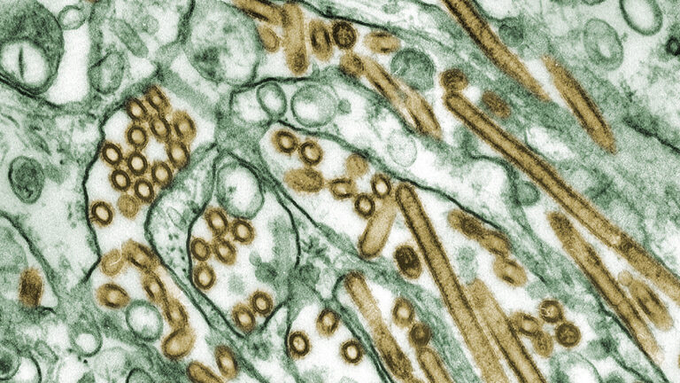May 14, 2025 | 15:08 GMT +7
May 14, 2025 | 15:08 GMT +7
Hotline: 0913.378.918
May 14, 2025 | 15:08 GMT +7
Hotline: 0913.378.918

Digitally colorized microscopic image of H5N1 virus particles (in gold).
The U.S. Department of Agriculture, which has been under pressure from scientists both at home and abroad to share more data on the H5N1 bird flu outbreaks in dairy cows, uploaded a large number of genetic sequences of the pathogen late Sunday.
The excitement that news generated in the scientific community quickly gave way to frustration, though, when researchers who tried to start analyzing the sequences realized the files did not include any information about when the samples that generated the data were collected, or where.
The expectation that the sequence data could help determine if the H5N1 virus has been changing as it transmitted from cow to cow and herd to herd gave way to a realization that it would do nothing of the sort.
“The sequences — they just all look like the [original] Texas sequences,” said Tom Peacock, a flu virologist at Imperial College, London. “For all we know, they are all the [original] Texas sequences.”
“The only date information is 2024. And that’s it.”
While the uploaded files included the type of animal from which the sample was collected, they didn’t include what part of the animal had been swabbed — a cow’s udder, for instance, or its nasal passages. In trying to assess whether cows are spreading the virus to one another the way human flu spreads, through viruses emitted from the nasal passages, that is critical information.
The USDA announced it was uploading 239 genetic sequences taken from cattle, cats, chickens, a skunk, a raccoon, a grackle, a blackbird, and a goose. Some of the sequences in the new upload have actually been in international databases for several weeks, Peacock said, but most are newly shared.
“Looking through them at the moment, there’s some interesting things going on there, but it makes it very, very hard to interpret what’s going on,” he said.
The hope was that by sharing the viral sequences scientists who do not work for the USDA could help assess whether the dangerous virus has acquired mutations that might make it easier for it to spread to and among mammals.
Peacock said the frustration he and others feel is amplified by reading or hearing claims from the USDA that suggest their assessment of the sequence data is that nothing concerning is happening to the virus, which has now been detected in 33 dairy herds in eight states.
“Epidemiology is show, don’t tell,” he said. “Show your work, please.”
Rick Bright, a pandemic planning consultant who has been vocally critical of the USDA for being slow to share sequence data, noted the disclosure had “taken a long time.”
On Sunday evening, he expressed gratitude for the government’s move. By Monday, he was expressing dismay about the limitations of the shared data.“It’s as if the USDA is intentionally trying to hide data from the world,” Bright, a former director of the Biomedical Advanced Research and Development Authority (BARDA) and the former head of the Rockefeller Foundation’s now-defunct Pandemic Prevention Institute, wrote to STAT.
The USDA announced on March 25 that it had confirmed H5N1 in dairy cows in Texas, a finding that has unsettled scientists who have followed this virus’ progression across the globe and into species after species of mammals. Until now, cows have not been among the animals seen to be infected by the virus.
The department initially shared a number of sequences, all of which appeared to be from the original outbreak in Texas.
While H5N1 is deadly to poultry and to a number of types of mammals, in cows it does not appear to cause severe illness. But milk production declines in infected cows and the milk produced is thick, off-color, and teeming with H5N1 viruses. Farmers have been told to destroy milk from infected cows.
While the USDA believes the virus is spreading from cow to cow, it is as yet uncertain how it is transmitting. The agency said in an update last week to a frequently-asked-questions document posted on its website that it had not found “significant concentration of virus in respiratory related samples, which indicates to us that respiratory transmission is not a primary means of transmission.”
It has suggested that transmission may be occurring through the milking process, perhaps through the sequential use of milking equipment or the movement of humans among farms.
statnews

(VAN) India is concerned about its food security and the livelihoods of its farmers if more US food imports are allowed.

(VAN) FAO's Director-General emphasises the need to work together to transform agrifood systems.

(VAN) Europe is facing its worst outbreak of foot-and-mouth since the start of the century.

(VAN) The central authorities, in early April, released a 10-year plan for rural vitalization.

(VAN) Viterra marked a significant milestone in its carbon measurement program in Argentina, called Ígaris, reaching 1 million soybean hectares measured.

(VAN) Minnesota study adds to growing evidence of human-accelerated erosion, which could jeopardize agriculture.

(VAN) QU Dongyu addresses International Conference of the Global Mountain Dialogue for Sustainable Development in Kyrgyzstan.